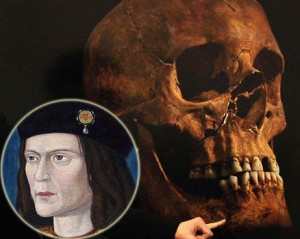Richard III remains confirmed through a DNA test
Ancient bones exposed under a parking lot have been confirmed as those of the medieval king Richard III, through a DNA test that also raises questions about the legitimacy of Henry VIII and other well-known English royals.
The team of genetics detectives reported Tuesday that DNA from the skeleton shows that the bones were Richard III’s, with a probability of 99.9994 percent.
Archaeologists had peeled back a parking lot in 2012 to dig the skeleton, which was among hidden relics of the Greyfriars Friary in Leicester, England, long the reputed funeral site of Richard III.
Earlier this year, a forensic study of the relics exposed that the doomed king—the last English. Monarch to die in combat—suffered 11 wounds at the time of his death, in a 1485 fight with the Tudors that ended England’s War of the Roses.But there had been remaining questions about whether the skeleton was really that of Richard III.
“The proof directly indicates that these are the leftovers of Richard III,” says geneticist Turi King of the University of Leicester in the U.K., who led the team reporting the results in the journal Nature infrastructure.
The scientists examined DNA hereditary along maternal lines, known as mitochondrial DNA, from two distantly connected modern-day relatives of Richard III’s sister. That DNA is a near ideal match for the maternal genes of the hunchbacked skeleton covered at the friary. What’s more, the DNA was “unusual,” King adds, containing stretches that don’t quite match anything in registries of European genes.
A numerical analysis led by David Balding and Mark Thomas of University College London took those inherent results and considered the chances that a man of Richard III’s age with battle wounds and a curved spine could turn up at Greyfriars and not be the slain king. They predictably expected that chance at 6.7 million to 1.
It is amazing how many people initially argued that these skeletal remains weren’t those of Richard III,” says bioanthropologist Piers Mitchell of the U.K.’s University of Cambridge,
In 2012 archaeologists peeled back a parking lot to excavate this skeleton, buried among rest of the Greyfriars Friary in Leicester, England.
